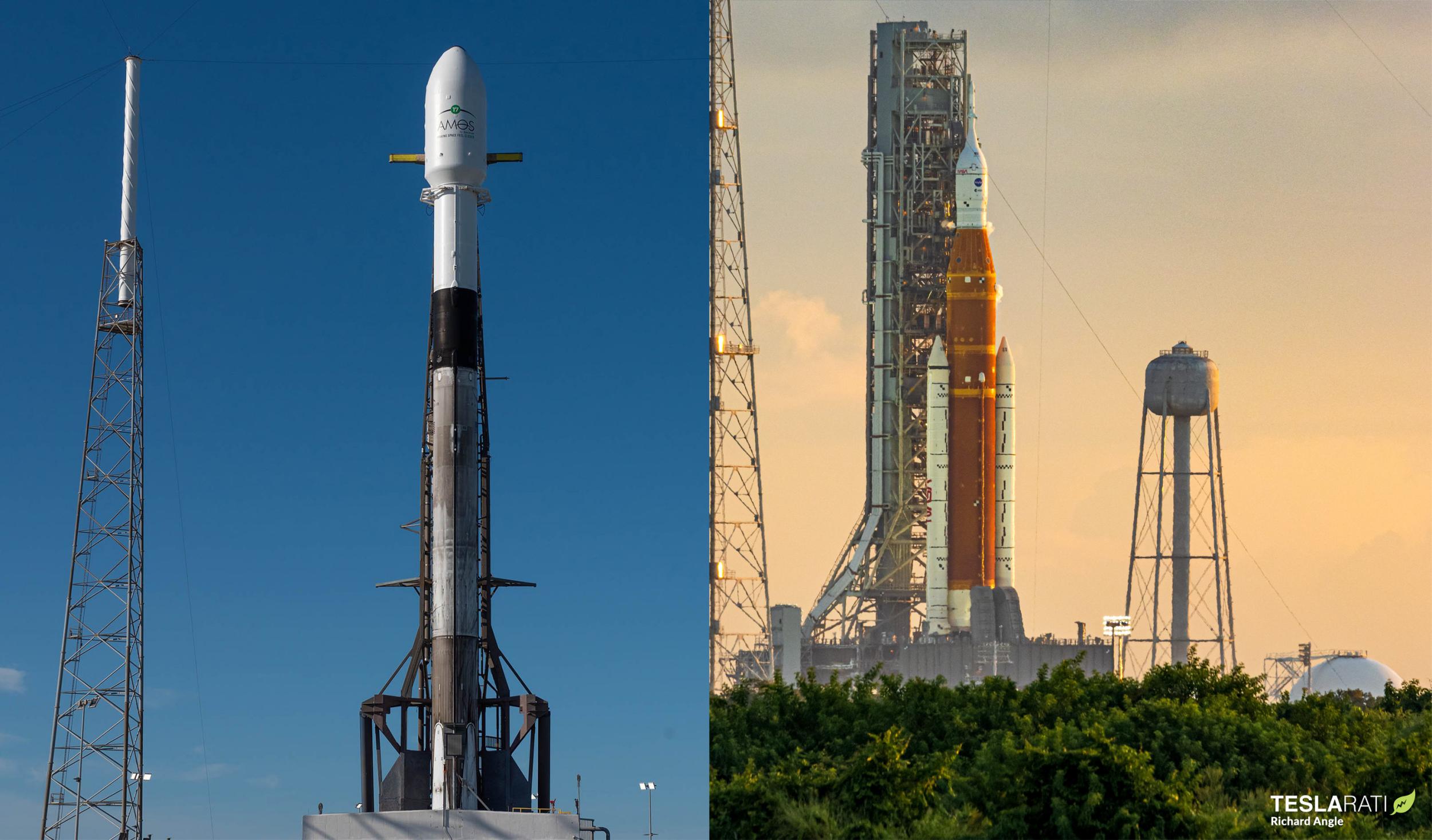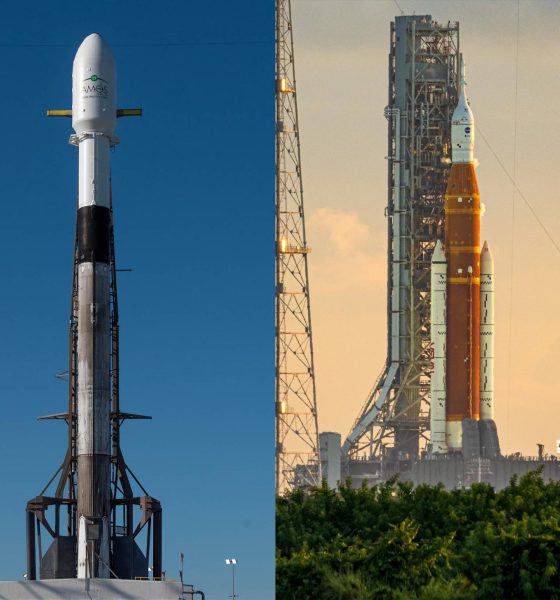

News
SpaceX, NASA batten down the hatches as another storm approaches Florida
SpaceX, NASA, and the rest of the Kennedy Space Center (KSC) and Cape Canaveral Space Force Station (CCSFS) are doing what they can to prepare for Tropical Storm Nicole’s imminent arrival.
The somewhat unexpected storm grew quickly in recent days and has become a system that could at least partially threaten the Space Coast and its tenants. After the likelihood of favorable weather conditions dropped to just 20% on November 7th, SpaceX announced later the same day that it would delay its next Falcon 9 launch from November 8th to no earlier than (NET) November 12th. Increasingly tight scheduling of one of SpaceX’s two Florida pads will likely trigger delays for at least two or three more November launches, magnifying the storm’s immediate impact.
In comparison, the situation facing NASA could become more serious. On November 4th, for the fourth time since April 2022, NASA rolled its first Space Launch System (SLS) rocket to KSC’s LC-39B pad for a third launch attempt. Due to a combination of the storm’s quick growth and the nature of the SLS rocket, the design of which was dictated more by political expediency than rational engineering, the agency was reluctant to roll the rocket back to shelter. By the time it was clear that Nicole would impact Cape Canaveral, it was too late for NASA to complete the multi-day rollback process.
In late September, Hurricane Ian created a similar situation. The threat of the tail-end of the storm bringing winds higher than the SLS rocket is rated to survive forced NASA to abandon a third launch attempt and instead roll SLS back to the Vehicle Assembly Building (VAB), which is rated to survive even a Category 5 hurricane. According to NASA, SLS is designed to withstand wind gusts as high as 137 km/h (85 mph). Even then, some senior officials were brazenly reluctant to stand down. Every round trip to and from the VAB guarantees weeks of delays before the next possible launch attempt. Additionally, while NASA has refused to offer more context, each crawler ride seemingly takes a toll on the SLS rocket, meaning that the vehicle can only handle a limited number of rollbacks before unspecified issues begin to arise.
As a result, even though high winds could apparently damage the first SLS rocket and orbit-capable Orion spacecraft, which represent 10-15 years of work and would cost a minimum of $4.1 billion to replace, NASA was nearly willing to play chicken with a hurricane. Ultimately, someone in the agency saw reason and took the threat seriously enough to return the rocket to the safety of the VAB. But just six weeks later, with no evidence that NASA seriously considered a rollback before it was too late, SLS is stuck at Pad 39B while an increasingly threatening tropical storm – verging on a Category 1 hurricane – approaches the Space Coast.
Because the rollback process (which takes about a day) requires days of preparation, NASA would have had to decide to return SLS to the VAB days in advance. Instead, even though NASA was already aware that a storm system was developing, the agency decided to roll the rocket out of the VAB to LC-39B late on November 3rd. Had NASA merely delayed rollout by a few days to allow forecasts of the storm system to become more confident, it’s unlikely that it would have moved forward with its rollout plans as the storm’s predicted impact worsened.
When Hurricane Ian threatened KSC, NASA decided to roll SLS back to the VAB after the odds of sustained hurricane-force winds grew to 6%. That makes NASA’s decision to roll SLS to the pad when it had a forecast showing a 4% chance of similar winds even stranger.
SLS will be forced to weather the storm while sitting unprotected at the launch pad. As of November 7th, NOAA models predicted a 7% chance of hurricane-force winds at Kennedy Space Center. The odds increased to 15% 12 hours later – briefly equivalent to Russian roulette. The latest forecast has dropped to a 10% chance of sustained wind speeds of 120 km/h (75 mph) or higher. It’s unclear what the SLS rocket’s tolerance for sustained winds is, but it’s likely lower than its tolerance for gusts of up to 85 mph.
With any luck, Nicole will fall on the right side of NASA’s gamble. In the meantime, to “provide sufficient logistical time to get back into launch status following the storm,” NASA has delayed its third SLS launch attempt from November 14th to November 16th. The bulk of Nicole’s impact will begin to be felt at KSC as early as November 9th and should last for several days.

Elon Musk
Elon Musk’s X will start using a Tesla-like software update strategy
The initiative seems designed to accelerate updates to the social media platform, while maintaining maximum transparency.

Elon Musk’s social media platform X will adopt a Tesla-esque approach to software updates for its algorithm.
The initiative seems designed to accelerate updates to the social media platform, while maintaining maximum transparency.
X’s updates to its updates
As per Musk in a post on X, the social media company will be making a new algorithm to determine what organic and advertising posts are recommended to users. These updates would then be repeated every four weeks.
“We will make the new 𝕏 algorithm, including all code used to determine what organic and advertising posts are recommended to users, open source in 7 days. This will be repeated every 4 weeks, with comprehensive developer notes, to help you understand what changed,” Musk wrote in his post.
The initiative somewhat mirrors Tesla’s over-the-air update model, where vehicle software is regularly refined and pushed to users with detailed release notes. This should allow users to better understand the details of X’s every update and foster a healthy feedback loop for the social media platform.
xAI and X
X, formerly Twitter, has been acquired by Elon Musk’s artificial intelligence startup, xAI last year. Since then, xAI has seen a rapid rise in valuation. Following the company’s the company’s upsized $20 billion Series E funding round, estimates now suggest that xAI is worth tens about $230 to $235 billion. That’s several times larger than Tesla when Elon Musk received his controversial 2018 CEO Performance Award.
As per xAI, the Series E funding round attracted a diverse group of investors, including Valor Equity Partners, Stepstone Group, Fidelity Management & Research Company, Qatar Investment Authority, MGX, and Baron Capital Group, among others. Strategic partners NVIDIA and Cisco Investments also continued support for building the world’s largest GPU clusters.
News
Tesla FSD Supervised wins MotorTrend’s Best Driver Assistance Award
The decision marks a notable reversal for the publication from prior years, with judges citing major real-world improvements that pushed Tesla’s latest FSD software ahead of every competing ADAS system.

Tesla’s Full Self-Driving (Supervised) system has been named the best driver-assistance technology on the market, earning top honors at the 2026 MotorTrend Best Tech Awards.
The decision marks a notable reversal for the publication from prior years, with judges citing major real-world improvements that pushed Tesla’s latest FSD software ahead of every competing ADAS system. And it wasn’t even close.
MotorTrend reverses course
MotorTrend awarded Tesla FSD (Supervised) its 2026 Best Tech Driver Assistance title after extensive testing of the latest v14 software. The publication acknowledged that it had previously criticized earlier versions of FSD for erratic behavior and near-miss incidents, ultimately favoring rivals such as GM’s Super Cruise in earlier evaluations.
According to MotorTrend, the newest iteration of FSD resolved many of those shortcomings. Testers said v14 showed far smoother behavior in complex urban scenarios, including unprotected left turns, traffic circles, emergency vehicles, and dense city streets. While the system still requires constant driver supervision, judges concluded that no other advanced driver-assistance system currently matches its breadth of capability.
Unlike rival systems that rely on combinations of cameras, radar, lidar, and mapped highways, Tesla’s FSD operates using a camera-only approach and is capable of driving on city streets, rural roads, and freeways. MotorTrend stated that pure utility, the ability to handle nearly all road types, ultimately separated FSD from competitors like Ford BlueCruise, GM Super Cruise, and BMW’s Highway Assistant.
High cost and high capability
MotorTrend also addressed FSD’s pricing, which remains significantly higher than rival systems. Tesla currently charges $8,000 for a one-time purchase or $99 per month for a subscription, compared with far lower upfront and subscription costs from other automakers. The publication noted that the premium is justified given FSD’s unmatched scope and continuous software evolution.
Safety remained a central focus of the evaluation. While testers reported collision-free operation over thousands of miles, they noted ongoing concerns around FSD’s configurable driving modes, including options that allow aggressive driving and speeds beyond posted limits. MotorTrend emphasized that, like all Level 2 systems, FSD still depends on a fully attentive human driver at all times.
Despite those caveats, the publication concluded that Tesla’s rapid software progress fundamentally reshaped the competitive landscape. For drivers seeking the most capable hands-on driver-assistance system available today, MotorTrend concluded Tesla FSD (Supervised) now stands alone at the top.
News
Elon Musk’s Grokipedia surges to 5.6M articles, almost 79% of English Wikipedia
The explosive growth marks a major milestone for the AI-powered online encyclopedia, which was launched by Elon Musk’s xAI just months ago.

Elon Musk’s Grokipedia has grown to an impressive 5,615,201 articles as of today, closing in on 79% of the English Wikipedia’s current total of 7,119,376 articles.
The explosive growth marks a major milestone for the AI-powered online encyclopedia, which was launched by Elon Musk’s xAI just months ago. Needless to say, it would only be a matter of time before Grokipedia exceeds English Wikipedia in sheer volume.
Grokipedia’s rapid growth
xAI’s vision for Grokipedia emphasizes neutrality, while Grok’s reasoning capabilities allow for fast drafting and fact-checking. When Elon Musk announced the initiative in late September 2025, he noted that Grokipedia would be an improvement to Wikipedia because it would be designed to avoid bias.
At the time, Musk noted that Grokipedia “is a necessary step towards the xAI goal of understanding the Universe.”
Grokipedia was launched in late October, and while xAI was careful to list it only as Version 0.1 at the time, the online encyclopedia immediately earned praise. Wikipedia co-founder Larry Sanger highlighted the project’s innovative approach, noting how it leverages AI to fill knowledge gaps and enable rapid updates. Netizens also observed how Grokipedia tends to present articles in a more objective manner compared to Wikipedia, which is edited by humans.
Elon Musk’s ambitious plans
With 5,615,201 total articles, Grokipedia has now grown to almost 79% of English Wikipedia’s article base. This is incredibly quick, though Grokipedia remains text-only for now. xAI, for its part, has now updated the online encyclopedia’s iteration to v0.2.
Elon Musk has shared bold ideas for Grokipedia, including sending a record of the entire knowledge base to space as part of xAI’s mission to preserve and expand human understanding. At some point, Musk stated that Grokipedia will be renamed to Encyclopedia Galactica, and it will be sent to the cosmos.
“When Grokipedia is good enough (long way to go), we will change the name to Encyclopedia Galactica. It will be an open source distillation of all knowledge, including audio, images and video. Join xAI to help build the sci-fi version of the Library of Alexandria!” Musk wrote, adding in a later post that “Copies will be etched in stone and sent to the Moon, Mars and beyond. This time, it will not be lost.”








